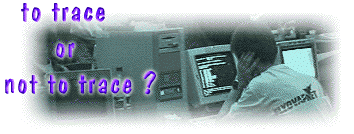
Easy tracing ?
by 3D Addict
Everybody who has been following the scene long enough will tell you that 3D generated images don't stand a chance against pixel drawn in a gfx compo.Actually, this is very true..As we all know it, nearly all the traced images which competed against pixelled images have allways been of very low quality.Simple images consisting of standard primitives, pre modelled checkboards, or some ready to use - seen/available everywhere models won't cut it.Most of the traced images produced by the scene wouldn't even make the game standard today.Which is rather disappointing as the scene has always been one step ahead of the game developers - but not in raytracing.
There seems to be a broad convenience among sceners that raytracing is not a real art, it's kind of cheating, because it's easy to do.If tracing is so easy, how come the quality of traced images is so low?Well, raytracing is easy in the beginning, and that's why we see so many low quality traces in gfx compos.It's easy to use primitives with some textures and lot's of flares.It's easy to press the render button and wait 15 minutes.it's easy to do something which requires no knowledge what so ever.
A high quality trace on the contrary, requires a good understanding of the program and a lot of experience.Something which can only be achieved from trying time after time after time and lots of patience.The question is: are all scene tracers too lazy to produce a high quality traces?
NO!Take a look at wild demos, do they seem to be of low quality?Most of them are of good and some of very high quality.Is making 3D animation easy then?No, I would say that it's even more difficult then making a still.The only advantage in making animation lies in the way human eye registers movement.We can't see frame by frame of the animation as flys can.Therefore an animation does not require as much work on details as a still image would, as we simply do not see it.There is no need of creating a very detailed spaceship with highly bumped mapping, if it will only be used for high speed flyby's.On the otherhand 3D animations are very time consuming and can be very frustrating.The main problem with making animations, is adjusting everything correctly - and this can be a real killer.
Imagine that you are in the process of adjusting some details(not object details)in a small part of your animation, and simply can't get it right.The part is only 5 sec. long but made you do hundreds of wireframe, gouraud and phong shadings so you spend hours and hours on renderwondering for at last to make the last raytraced preview.Just when you thought that everything was perfect after watching the final raytraced version, you confidently switch to higher resolution, more frame rates and colors and wait looooong hours or days for the very final only 5 sec. long animation.To your big surprise everything looks totally screwed.The full screen version looks so different from the small perfect preview that you begin accusing yourself of rendering the wrong version of your preview(as you have hundreds of them on your HD).Unfortunately/fortunately you rendered the right one.The switch from 1/4 or smaller screen size to full screen can make so drastic visual difference that it's shocking.Small details(which make all the differences) as depth field are simply not visible good enough in smaller renders.After some time you managed to do this 5 sec. animation just right, but what an effort!.

This example may sound a bit extreme, but it's not fictious.With time, a tracer will become more experienced and will be able to avoid lots of problems.But some problems will remain all the same.The most frustrating aspect of making animations, or raytracing in all, is the time factor.
Because of the limited amount of CPU power, the tracer is more or less bound to it's own limits of patience.The computer is clearly the limiting factor here as not everyone can afford to buy a faster computer.
We should all respect the tracers who participate in wild demo compos, even if their contibutions are not so good, as they put a lot efeffort in it.
All in all, making 3D animations is a very hard work, which requires lots of commitment and very patient minds - that is, unless you own an MP workstation....
Making high quality stills is easier and not as frustrating, but it still requires a lot of effort.In stills the small object details makes the big differences.The more detailed the objects are the better the overall visual impression of the final render.Building a very detailed model, which looks good from all angles, is not an easy task.Making use of the right combinations of texture/light settings is even harder, but adjusting all objects in your scene so they are 'just right', is the hardest part of all - unless you are not interested in creating a fullblown killer trace.(I haven't done't yet)
Needless to say, all serious tracers spend a lot of time on creating their 3D Environments .Environments which can be easily reused.A good model can be used over and over in different images.An advantage which is often misused by some tracers.This is cheating in some way, just as an 2D artist redraws a picture.I'm not a big fan of redrawing or making use of the same objects over and over again as I believe that artists should always improve their skills, by constantly seeking new challenges and explore new possibilities...
One thing is clear for me though: all high quality traces require just as much work, experience and talent as does the making of high quality pixel images.And one last thing: tracing is only easy for those who make it easy for them selfs.






